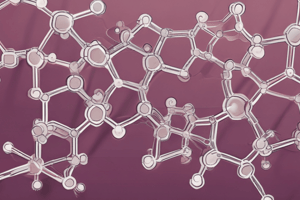Podcast
Questions and Answers
In the reaction of an aldehyde with hydrazine, what derivative would be formed?
In the reaction of an aldehyde with hydrazine, what derivative would be formed?
- Oxime
- Imine
- Semicarbazone
- 2,4-dinitrophenylhydrazone (correct)
What is the product when benzaldehyde reacts with semicarbazide?
What is the product when benzaldehyde reacts with semicarbazide?
- Cyclopropanone oxime
- The semicarbazone (correct)
- The ethylene ketal
- Acetaldehydedimethylacetal
Which compound is formed from the reaction of cyclobutanone with semicarbazide?
Which compound is formed from the reaction of cyclobutanone with semicarbazide?
- Cyclopropanone oxime
- The ethylene ketal
- The semicarbazone (correct)
- 2,4-dinitrophenylhydrazone
When hexan-3-one reacts with ethylene glycol, what is the product called?
When hexan-3-one reacts with ethylene glycol, what is the product called?
What compound is obtained from the reaction of formaldehyde with methanol in acidic conditions?
What compound is obtained from the reaction of formaldehyde with methanol in acidic conditions?
What derivative is formed when an aldehyde reacts with hydroxylamine?
What derivative is formed when an aldehyde reacts with hydroxylamine?
Which compound is produced when benzaldehyde reacts with phenylhydrazine?
Which compound is produced when benzaldehyde reacts with phenylhydrazine?
What is the outcome of the reaction between hexanal and semicarbazide?
What is the outcome of the reaction between hexanal and semicarbazide?
Study Notes
Molecular Formula and Unsaturation
- Compound (A) has a high degree of unsaturation but does not decolourise bromine water or Baeyer's reagent, indicating the presence of unsaturation due to an aromatic ring.
- Compound (A) is phenyl methyl ketone (acetophenone) based on its molecular formula.
Reactions due to α-Hydrogen Acidity
- Aldehydes and ketones undergo reactions due to the acidic nature of α-hydrogen.
- The acidity of α-hydrogen atoms of carbonyl compounds is due to the strong electron withdrawing effect of the carbonyl group and resonance stabilisation of the conjugate base.
Aldol Condensation
- Aldehydes and ketones having at least one α-hydrogen undergo aldol condensation in the presence of dilute alkali as catalyst to form β-hydroxy aldehydes (aldol) or β-hydroxy ketones (ketol).
- The aldol and ketol readily lose water to give α,β-unsaturated carbonyl compounds.
Identifying Compounds that Undergo Aldol Condensation and Cannizzaro Reaction
- Methanal and benzaldehyde undergo Cannizzaro reaction but not aldol condensation.
- 2-Methylpentanal, benzophenone, cyclohexanone, and 2,2-dimethylbutanal undergo aldol condensation but not Cannizzaro reaction.
- 1-Phenylpropanone and phenylacetaldehyde undergo both aldol condensation and Cannizzaro reaction.
Converting Ethanal to Other Compounds
- Ethanal can be converted to butane-1,3-diol through aldol condensation.
- Ethanal can be converted to but-2-enal through aldol condensation followed by dehydration.
- Ethanal can be converted to but-2-enoic acid through aldol condensation followed by oxidation.
Aldol Condensation Products from Propanal and Butanal
- Four possible aldol condensation products can be formed from propanal and butanal, with each aldehyde acting as both nucleophile and electrophile.
Identifying Compounds
- An organic compound with the molecular formula C9H10O forms 2,4-DNP derivative, reduces Tollens' reagent, and undergoes Cannizzaro reaction, and on vigorous oxidation, it gives 1,2-benzenedicarboxylic acid, indicating it is phenylacetaldehyde.
Derivatives of Aldehydes and Ketones
- Different derivatives of aldehydes and ketones include cyanohydrin, acetal, semicarbazone, aldol, hemiacetal, oxime, ketal, imine, and 2,4-DNP-derivative.
Naming and Drawing Structures of Compounds
- The IUPAC names of various ketones and aldehydes can be determined using the IUPAC system of nomenclature.
- The structures of various derivatives, such as 2,4-dinitrophenylhydrazones, oximes, ketals, and hemiacetals, can be drawn.
Studying That Suits You
Use AI to generate personalized quizzes and flashcards to suit your learning preferences.
Description
This quiz tests your knowledge on identifying aromatic compounds based on molecular formulas and chemical reactions. The quiz specifically focuses on distinguishing between compounds containing unsaturation due to aromatic rings and those that do not decolourise bromine water or Baeyer’s reagent.




